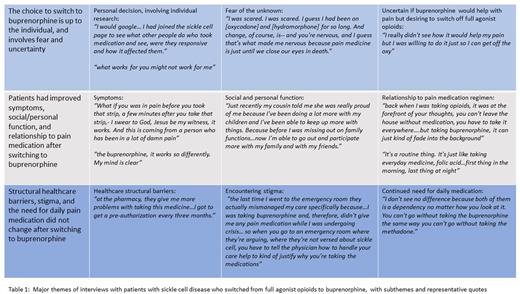Abstract
Introduction: Pain is the most common complication of sickle cell disease (SCD), and full agonist opioids are most commonly used for treatment. However, full agonist opioids may become ineffective with chronic use and safety concerns arise with escalating doses. Opioids can cause significant side effects and contribute to the stigmatization of patients with SCD. Buprenorphine is a partial opioid receptor agonist and antagonist that is approved for treatment of opioid use disorder and for chronic pain. Initial studies among adults with SCD show buprenorphine is safe and decreases acute care utilization (David et al. Blood 2018), (Osunkwo et al. Blood 2019). No study yet describes the perspective of adult patients with SCD regarding buprenorphine use. The purpose of this qualitative study was to 1) understand the experience of adults with SCD who use buprenorphine for chronic pain, and 2) gather patient-centered data to inform discussions with patients considering buprenorphine.
Methods: In this Institutional Review Board approved study, we conducted semi-structured, telephone interviews with 13 adult patients with SCD cared for at Johns Hopkins Sickle Cell Center for Adults prescribed buprenorphine for chronic pain between December, 2020 and April, 2022. Interviews lasted 20 to 60 minutes, were recorded, transcribed, and analyzed using grounded theory. Two study members (PL, ME) individually coded the first three transcripts, and then created a codebook, resolving coding discrepancies by consensus. In an iterative process, as additional transcripts were coded and themes emerged, transcripts were re-coded and codes grouped into themes and subthemes.
Results: We contacted 30 eligible subjects and completed interviews with 13; nine women and four men, aged 26 to 60 years. Before initiating buprenorphine, subjects' full agonist opioid regimens ranged from 60 to 500 morphine milligram equivalents (MMEs) daily. Most (11/13) subjects were taking buprenorphine at the time of participation and the average duration of therapy at the time of interview was 33 months (SD 18, range 7 to 78 months).
Three themes emerged from the interviews (Table 1): 1) the choice to switch to buprenorphine is up to the individual and involves fear and uncertainty; 2) patients had improved symptoms, social/personal function, and relationship to pain medication after switching to buprenorphine; 3) structural healthcare barriers, stigma, and the need for daily medication for pain did not change after switching.
For theme 1), patients were skeptical that buprenorphine would effectively treat their pain, and afraid of the unknown, but were willing to switch in order to come off full agonist opioids. Patients noted that it was a personal decision, involving their own research and often in discussion with other patients with SCD.
For theme 2), patients described a clearer mental state and ability to "get up and go" on buprenorphine, contrasted with drowsiness and uncontrolled pain on previous full agonist regimens. There was more engagement in family relationships-one patient described her prior need to teach her young children how to recognize opioid overdose, contrasted to recently effectively transitioning her daughter to a different school. Patients noted a less intrusive pain medication regimen, with buprenorphine becoming a "background" medication, contrasted with full agonist opioids occupying thoughts and affecting activities.
For theme 3), patients noted continued barriers within healthcare structures, including issues with the pharmacy and encountering stigma in the emergency room, and continued reliance on daily medication for pain.
Conclusions: Patients who switched from daily full agonist opioids to buprenorphine for treatment of SCD chronic pain described improved symptoms and function, but still encountered healthcare structural barriers; the choice to switch involved uncertainty but was the individual's choice. Limitations include the limited number of participants and the potential for self-selection bias. Patients should be invited to discuss their burden of symptoms, level of intrusiveness of their current regimen, and interest in or skepticism of buprenorphine. This study can be used when talking with patients about treatment options by providing examples of what patients taking buprenorphine say about its effect on their symptoms and lives, and what they considered when deciding to switch.
Disclosures
Lauriello:HRSA: Research Funding; PCORI: Research Funding. Lanzkron:bluebird bio: Other: Adjudication committee, Research Funding; CSL-behring: Research Funding; Novartis: Consultancy, Research Funding; Pfizer: Consultancy, Current equity holder in private company; Novo Nordisk: Other: Adjudication committee; Teva: Current equity holder in private company; PCORI: Research Funding; HRSA: Research Funding; Takeda: Research Funding; Novartis: Research Funding; GBT: Research Funding; Imara: Research Funding; Glycomimetics: Consultancy. Pecker:Novo Nordisk: Consultancy; GBT: Research Funding; Global Blood Therapeutics: Consultancy.
Author notes
Asterisk with author names denotes non-ASH members.


This feature is available to Subscribers Only
Sign In or Create an Account Close Modal